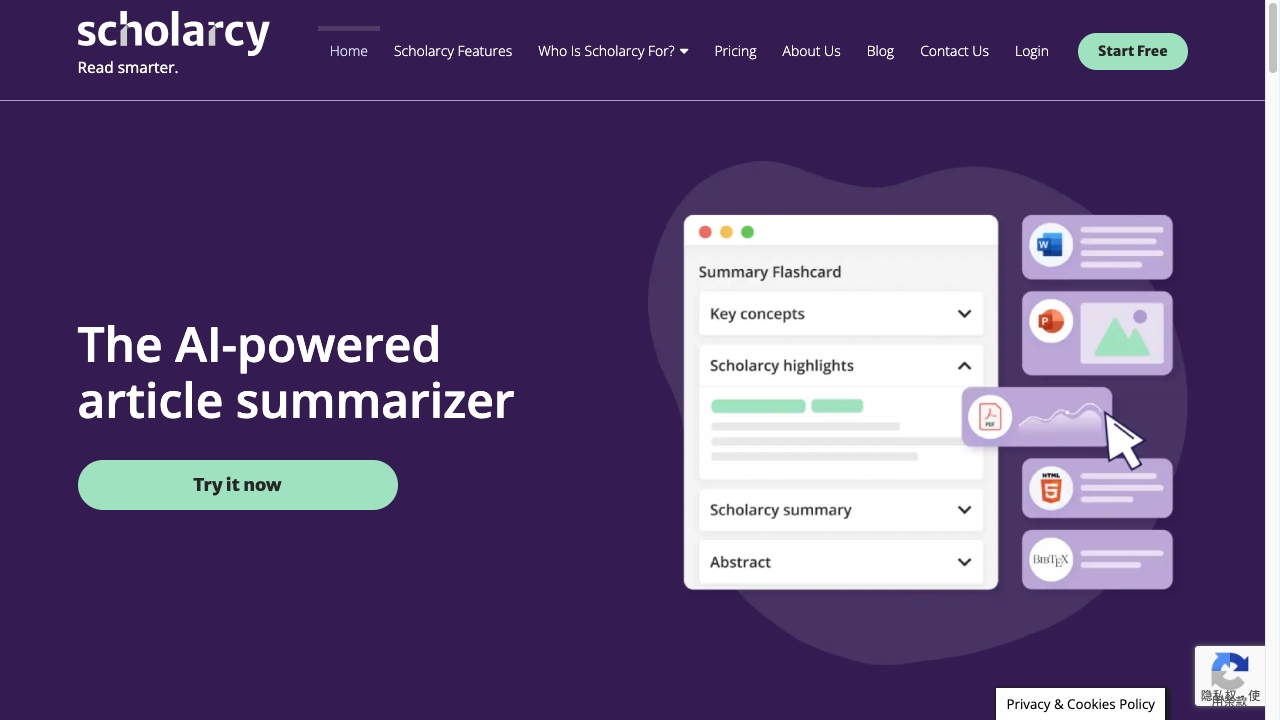- Home
- AI Summarizer
- Scholarcy

Scholarcy
Open Website-
Tool Introduction:AI summaries for research: key points, references, flashcards.
-
Inclusion Date:Oct 21, 2025
-
Social Media & Email:
Tool Information
What is Scholarcy AI
Scholarcy AI is an AI-powered summarizer built for long-form content, especially academic articles and complex research papers. It rapidly extracts key facts, figures, methods, and references, turning dense documents into clear, interactive summary flashcards you can scan in seconds. By surfacing contributions, limitations, and cited sources, Scholarcy AI helps you understand evidence faster, compare studies, and organize knowledge for literature reviews. Whether you’re processing PDFs or online articles, it saves hours of reading while preserving essential context and links for deeper follow-up.
Scholarcy AI Key Features
- AI summaries of research papers: Condenses long articles into concise, structured overviews that are easy to scan.
- Extraction of key facts and figures: Identifies important findings, statistics, and quantitative results for quick reference.
- Reference and citation capture: Pulls out cited sources to help you trace evidence and build bibliographies.
- Interactive summary flashcards: Converts lengthy texts into navigable flashcards for rapid review and knowledge retention.
- Highlighting contributions and limitations: Surfaces what a study adds and where its constraints lie to inform critical reading.
- Organization and comparison: Helps group summaries and compare multiple papers when conducting literature reviews.
- Works with long-form documents: Handles research papers, reports, and detailed articles without losing core context.
Who Should Use Scholarcy AI
Scholarcy AI suits students, researchers, and educators who need to digest academic literature quickly; librarians and analysts conducting literature reviews; journalists and policy researchers summarizing reports; and professionals who must extract evidence, references, and insights from lengthy documents without reading every line.
How to Use Scholarcy AI
- Collect the article, report, or research paper you want to analyze (e.g., PDF or online text).
- Import or paste the document into Scholarcy AI and start the summarization process.
- Review the generated summary flashcard, scanning key findings, methods, and figures.
- Open the references section to explore cited sources and follow links for deeper reading.
- Save or organize the summary alongside related papers for literature review workflows.
- Refine your reading list by comparing multiple summaries and prioritizing the most relevant studies.
Scholarcy AI Industry Use Cases
University research teams can screen hundreds of papers to identify relevant studies and extract comparable metrics for systematic reviews. In pharma and biotech, analysts can summarize clinical and preclinical papers to track outcomes and methodologies. Consulting and policy groups can condense lengthy government or market reports to brief stakeholders. Journalists can quickly pull key facts and references from technical articles to support evidence-based reporting.
Scholarcy AI Pros and Cons
Pros:
- Significantly reduces time spent reading dense research papers.
- Extracts facts, figures, and references for evidence tracing.
- Interactive flashcards improve understanding and recall.
- Helps organize and compare studies for literature reviews.
- Supports critical reading by surfacing contributions and limitations.
Cons:
- Summaries may miss nuanced context from full texts, requiring manual verification.
- Complex tables, formulas, or poorly formatted documents can affect extraction quality.
- Best used as a screening aid, not a replacement for reading pivotal sources.
Scholarcy AI FAQs
-
Does Scholarcy AI work with PDFs and long reports?
Yes. It is designed for long-form content such as PDFs, research papers, and in-depth articles.
-
What kind of information does it extract?
It surfaces key findings, quantitative results, methods, and references to help you assess evidence quickly.
-
Can I use it for literature reviews?
Yes. You can summarize multiple papers, group them by topic, and compare findings to prioritize reading.
-
How accurate are the summaries?
They provide a strong overview for screening, but important decisions should still rely on the original text.
-
Does it handle non-technical writing?
It works on a range of long-form texts, but it is especially effective on structured academic and technical documents.



